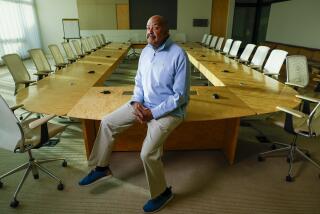POWER STATIONS: Where SoCal’s Political Elite Meet
- Share via
1. California Club. Thanks for the memories. This was Los Angeles’ most important political hot spot in the days when politics and government were run by a few CEOs and lawyers who called themselves The Committee of 25. With the waning of L.A.’s corporate clout, the club has become something of a museum of power. But enough big shots, including Mayor Richard Riordan and his powerful behind-the-scenes advisor, attorney Bill Wardlaw, hang out here to make it a place where decisions are still made.
2. Jonathan Club. The owner of a now-disappeared corporation once explained the difference between the Jonathan Club and the California Club: “I belong to the California Club. My sales manager belongs to the Jonathan Club.” Even so, many a deal has been cut--and will be cut--over lunch and drinks at this venerable downtown spot.
For the record:
12:00 a.m. July 27, 1997 For The Record
Los Angeles Times Sunday July 27, 1997 Home Edition Los Angeles Times Magazine Page 4 Times Magazine Desk 1 inches; 18 words Type of Material: Correction
In “Power Stations’ (June 22), Los Angeles City Councilman Richard Alatorre was incorrectly referred to as a county supervisor.
3. City Club. This latest addition to the downtown scene is popular with the younger power set. It’s not burdened with the vestiges of older clubs’ men-only tradition, and costs less. 4. Pacific Dining Car. The big lobbyists and politicians gather for breakfast here, just west of the Civic Center, where the tables are far apart enough to make eavesdropping difficult.
5. Latham & Watkins. Famed Latham & Watkins lawyer Randy Stoke’s tradition of helping raise the money, elect the council members, write the legislation and get it signed into law has been picked up by the firm’s new generation of power-lawyer lobbyists. Republicans and Democrats alike are at home in this firm, which made its name dealing with nonpartisan local governments. A power in the Civic Center and the state Capitol.
6. Office of Central City Assn. Once a dominant power and the front for the California Club crowd, the association floundered for several years but has resurfaced as a lobbying force at City Hall under the leadership of president Carol Schatz. The association led the advocacy effort that is pushing the downtown sports arena.
7. The Do-Gooder building. That’s not really the name of the three-story building at Veteran Avenue and Pico Boulevard. But it fits. The campaign-reform group Common Cause, the Center for Governmental Studies and a gun-control organization are based here. This is where Prop. 208, the political reform measure, was hatched.
8. The Brentwood ZIP Code (90049) where Riordan and state Sen. Tom Hayden live.
9. The Summit Hotel Bel Air. This quiet hotel off the 405 Freeway at Sunset Boulevard is the Westside’s political power breakfast spot, with a list of diners headed by Riordan.
10. The Reason Foundation. A nationally recognized purveyor of libertarian philosophy, this Westside think tank wields considerable power locally. Its studies on privatizing public enterprises such as Los Angeles International Airport heavily influenced the Riordan administration.
11. KCRW studio at Santa Monica College. “Which Way L.A.?,” Warren Olney’s newsy discussion show that greatly influences local politics and government, is produced here.
12. Boulevard Cafe. This excellent restaurant, located on Martin Luther King Jr. Boulevard and owned by former Assemblyman Frank Holoman, is the breakfast gathering place for the African American community’s political insiders.
13. Midnight Special bookstore. The Left is pretty well isolated in this era, but not at the readings, book signings and meetings at this earnest Santa Monica bookstore on the Third Street Promenade.
14. Jerry’s Famous Delis in the Valley--Encino, Studio City and Woodland Hills. Where the Valley’s political players meet for breakfast. Froman’s Deli in Encino is another.
15. Sportsman’s Lodge. Before even Tom Bradley, Sportsman’s Lodge in Studio City was where all the political events in the Valley were held, as well as weddings. It’s still in play. Riordan began his reelection campaign here.
16. Los Angeles County Federation of Labor office. This shabby two-story building just west of downtown is becoming a real political hot spot under the leadership of executive secretary Miguel Contreras. During the Bradley administration, the County Fed operated in the back rooms, working with business and political leadership on downtown redevelopment, Metro Rail and bringing the Raiders to town. The new-look Fed operates in public, often in the streets, as it organizes the poor of L.A.’s sweatshop economy.
17. MTA headquarters. Want to see some of the city’s most powerful lobbyists in one place? Take the subway to Union Station and walk the short distance to the faux Art Deco headquarters of the Metropolitan Transportation Authority.
18. Office of the Archdiocese of Los Angeles. L.A.’s greatest politician is a Catholic priest, Cardinal Roger Mahony. Although Mahony doesn’t get involved in many issues, he usually wins when he does. His clout with the mayor kept alive the Hope in Youth anti-gang group he supports, and his connections permitted the archdiocese to buy prime county land for a new cathedral.
19. Brotherhood Crusade offices. Under the direction of philanthropist-entrepreneur Danny Bakewell, this African American community version of the United Crusade funds a variety of social service programs and is a player in most big decisions by L.A.’s black leadership.
20. Tamayo. This East Los Angeles restaurant draws politicos and business types in the Latino community, especially those associated with TELACU, the powerful business and social service organization that fuels county Supervisor Richard Alatorre’s political machine.
More to Read
Get the L.A. Times Politics newsletter
Deeply reported insights into legislation, politics and policy from Sacramento, Washington and beyond. In your inbox twice per week.
You may occasionally receive promotional content from the Los Angeles Times.










